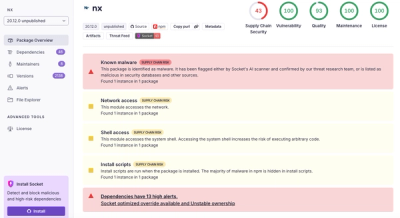
Security News
/Research
Wallet-Draining npm Package Impersonates Nodemailer to Hijack Crypto Transactions
Malicious npm package impersonates Nodemailer and drains wallets by hijacking crypto transactions across multiple blockchains.
A simple blog engine—but not simpler than it should be.
Or run the project from the root of this repository:
poetry install
./bin/dev-server.sh
travels and best.my-cool-experiments-with-chatgpt.my-cool-blog.org -> my-cool-blog.org/<language>/For examples check brigid.plugins directory.
Set environment variables:
BRIGID_ENVIRONMENT="prod"
# Path to your content directory.
# You can find examples here:
# - ./test-content
# - https://github.com/Tiendil/tiendil-org-content/tree/main/content
BRIGID_LIBRARY_DIRECTORY="<path-to-your-content-dir>"
# Optional: Brigid will store files here for your reverse proxy to serve.
BRIGID_API_CACHE_DIRECTORY="<path-to-your-cache-dir>"
# Python list of allowed origins for CORS:
BRIGID_ORIGINS="[\"https://my-site.org\"]"
Install and run the server:
pip install brigid uvicorn
uvicorn brigid.application.application:app \
--host 0.0.0.0 \
--port 8000 \
--workers 4
That’s it! You’ll have a server running on port 8000.
Consider the following for production deployment:
A subjective list of design principles I follow in this project:
FAQs
Static site generator.
We found that brigid demonstrated a healthy version release cadence and project activity because the last version was released less than a year ago. It has 1 open source maintainer collaborating on the project.
Did you know?

Socket for GitHub automatically highlights issues in each pull request and monitors the health of all your open source dependencies. Discover the contents of your packages and block harmful activity before you install or update your dependencies.

Security News
/Research
Malicious npm package impersonates Nodemailer and drains wallets by hijacking crypto transactions across multiple blockchains.

Security News
This episode explores the hard problem of reachability analysis, from static analysis limits to handling dynamic languages and massive dependency trees.

Security News
/Research
Malicious Nx npm versions stole secrets and wallet info using AI CLI tools; Socket’s AI scanner detected the supply chain attack and flagged the malware.